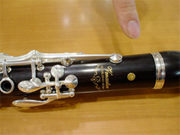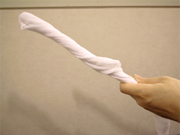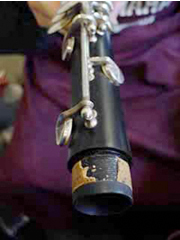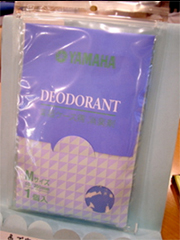Care and Maintenance of a Clarinet
Seasonal care and maintenance
Precautions against cracking in winter
Why do you imagine that woodwind instruments are more prone to cracking in winter? The reason is that-depending on the atmospheric or room temperature-the instrument may be fairly cold in winter before it is played. However, the temperature of the breath of the clarinetist playing the instrument will be the same as his body temperature-that is, around 36º -37º. As a result, when the clarinetist blows into the instrument, the inside of the body of the clarinet will be warmed up and the instrument's temperature will rise in one fell swoop. Accordingly, the wood will try to expand outwards; however, since the outside of the instrument is constricted by the low external temperature, the instrument may be unable to withstand this temperature difference and crack.

A section of the upper body that is prone to cracking
Incidentally, another reason for cracking besides temperature difference is drastic difference in humidity. Hence, care is also required at times of high humidity (such as during the rainy season), as well as in winter.
In order to protect the clarinet from cracking during cold periods, it is essential that after taking the instrument out of its case, you warm it up by putting it inside a coat or pressing it against your body. Avoid playing the instrument until it is properly acclimatized to room temperature. The part of the clarinet that is most prone to cracking is the section near the mouthpiece (known as the upper body), which is most easily warmed by the breath of the clarinetist. If the cracking is inconspicuous, it may even go unnoticed, so from time to time please hold up the instrument and inspect it visually. If you should find cracks in the instrument, take it to a specialist shop for repairs as quickly as possible, as the cracking will gradually spread, making repair progressively more difficult. In the worst case, the clarinet may even split apart.

Bore oil for protecting the inside of the body
Naturally, even a split clarinet can be repaired. If the cracks are large, the split section can be closed up again using a vice (similar to the way in which broken bones are set), or the split body can be replaced. It will be impossible, however, to restore the instrument to its original condition-thus prevention is definitely better than cure.
Another means of dealing with moisture is "bore oil," which protects against change in the internal shape of the instrument by absorbing moisture in the tube. When using bore oil, first remove the moisture from inside the tube and clean it thoroughly, then soak a little bore oil into a fresh swab and spread the oil around inside the tube, so as to form an extremely thin film of bore oil over the tube's interior surfaces.

The inside of the body is cleaned with a gauze which is rolled up as shown
Checking the joint
When you assemble a woodwind instrument, such as a clarinet, flute, bassoon, or saxophone, and then try to play it, the joint may sometimes rattle slightly and feels loose. This requires special attention. The reason is probably that the cork in the joint has deteriorated and no longer fits snugly.

Since corks are non-durable items, they need to be changed periodically. As a rule of thumb, the cork should be changed every year or two (although this varies according to how the instrument is used and stored). In fact, in some instruments that are brought in for repair, this cork in the joint is quite worn out. With the clarinet shown in the photograph, the cork has come away easily in the hand. A cork that has deteriorated and worn out will come away easily, and in some cases may even flake right off. If this happens, take the instrument to a music shop for repair.
A cork will deteriorate if too much cork grease is applied to it. If a new cork is hard to insert when the tube is assembled, cork grease is applied to make it slide in more easily. If the cork will fit in easily, there is no need to use cork grease. A further concern is that if the grease permeates the cork, the cork adhesive will dissolve, so be careful never to apply too much grease. In particular, if cork grease is not wiped off before the instrument is put away in its case, the cork will deteriorate rapidly. Make a habit of thoroughly wiping any grease off the cork when you have finished playing the instrument.

Gluing in a new cork (bottom photograph) The cork is cut diagonally in cross-section so that the thickness of the bonded section will be constant.
Combating odors in the rainy season
Deodorant is recommended in the rainy season, when there is a lot of moisture around. Simply put it in the instrument case and it will remove unpleasant odors. Use products like this to keep your instrument fresh and lift your spirits in a damp and clammy rainy season.
Points to note
The color of the surface of an electro-plated wind instrument may change over time, depending on the properties of the plating. This will not affect the playing of the instrument in any way, however.
It is easy to make the parts that have changed color look attractive by cleaning them.
* Use the appropriate cleaning product for the type of plating used on your instrument.

Deodorant for use in a small case
Musical Instrument Guide:Clarinet Contents
Structure
How the Instrument is Made
Choosing an Instrument
Trivia
- "I Broke My Clarinet" is a French folk song
- Inspiring composers
- In Italy, a single B♭ clarinet
- At one time, most clarinets were made of boxwood
- In vogue in the 1900s-the metal clarinet
- A transparent clarinet?
- Famous clarinet works: concertos
- Famous clarinet works: chamber music
- What is the relationship between hertz and cents?
